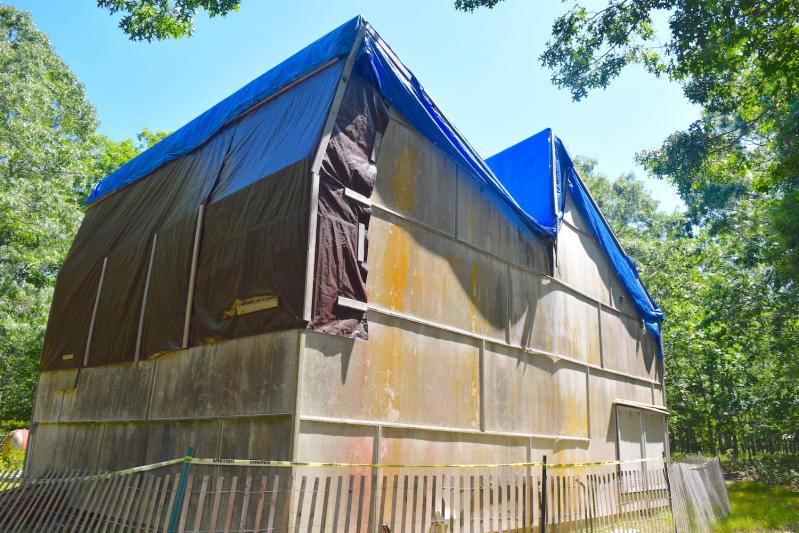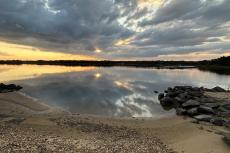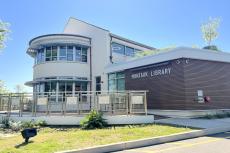The finishing work has been done on a management plan for what is to be called the Brooks-Park Historic Site, the 11-acre property on Neck Path in Springs that belonged to the Abstract Expressionist artists James Brooks and Charlotte Park, the director of East Hampton Town’s Land Acquisition and Management Department told the town board during a public hearing last Thursday.
On Tuesday, the board adopted the management plan.
Board members had requested modifications following reviews of the plan in July and August, and the changes have been implemented, Scott Wilson said. The changes are minor. A committee that has been working to preserve the site and restore its derelict structures had proposed that it be called the Brooks-Park Arts and Nature Center. While the Brooks-Park Historic Site will be the site’s name for official purposes, that will not preclude the committee from using its preferred name, Mr. Wilson told The Star this week.
The board had sought supplemental documentation, including condition reports and photographs of the property in its present state and at the time of its 2013 acquisition by the town, which have now been included in the management plan. A mission statement has been moved to a section on goals for the site, and additional description of the land and its flora and fauna has been added. Wording such as “will” and “shall” has been changed to “could” and “may.”
“Any management plan is more of a guide than a how-to manual,” Mr. Wilson clarified. “These are suggestions, not mandatory requirements.”
When the town acquired the property, using the community preservation fund, the plan was to demolish the structures, including the married artists’ respective studios, a residence, and a cottage. The $1.1 million purchase was meant to create open space, but a group of Springs residents formed the Brooks Park Heritage Project and lobbied for preserving the buildings instead.
The Brooks-Park buildings were designated a town historic landmark in 2014, which allowed for C.P.F. money to be spent toward the site’s restoration, but not for its management. In 2018, the town board approved a management and stewardship plan for properties acquired with the community preservation fund, which included an estimated $850,000 expenditure to restore the Brooks-Park property.
The following year, however, the town’s property-management committee concluded that the cost of the structures’ restoration was prohibitive. It recommended that they be demolished and the site cleared.
That spurred a renewed push for a not-for-profit entity to manage the property. After a long-anticipated historical and architectural assessment of the property was delivered to the town board in March, members indicated a readiness to embrace its restoration and conversion.
Members of the committee that worked to develop the management plan envision a center that will attract not just lovers of art but also of nature, birds, hiking, architecture, and historic preservation.
Brooks, who died in 1992, and Park, who died in 2010, “were key to development of Abstract Expressionism in New York and the United States,” Mr. Wilson said, and “a vital part of local history that features a migration of legendary visual artists to Long Island’s South Fork since the late 19th century.”
Nine residents, many of them artists, spoke during last Thursday’s hearing, all supportive of the management plan. The artist George Negroponte told the town board that restoration of the site and structures will be a step toward restoring the artists’ reputations, which he said have slipped somewhat. “When I studied painting at Yale in the early ‘70s, everybody talked about James Brooks,” he said. At Mr. Negroponte’s second New York City exhibition, he recalled, his work hung next to Park’s, and she attended the opening. “For a young painter, I can’t tell you what an honor it was to have Charlotte right next to me, and to meet her.”
The current retrospective of Brooks’s work at the Parrish Art Museum in Water Mill “is really the first attempt to begin to restore the reputation of these two fantastic artists,” Mr. Negroponte said. “I think it’s truly impossible to understand how well known they were in the ‘70s.” Restoring the property and structures is “fixing history in a way that it should be. . . . This project is really way, way bigger than just this community, because the art of these two wonderful people, I think, needs to be elevated back to its proper place.”
Jonathan Foster spoke of seeing Willem de Kooning and Lee Krasner walking or biking on Springs roads, and recalled the night that Jackson Pollock was killed in an automobile accident, “just down the road from my grandfather’s barn.” The artists “are very much a part of life here, as were the farmers and the fishermen,” he said. When he visited the Peggy Guggenheim Collection in Venice, where works by Pollock and other Abstract Expressionists are featured, “I immediately felt like I was back in East Hampton.”
While the town has changed dramatically, the restored Brooks-Park site “will bring some of that feeling to the East Hampton of today,” said Mr. Foster. “Both James Brooks and Charlotte Park loved the pure, natural quality of the East End, and their art reflects that in its quality and its natural forms.”
Restoration of the site, said Katherine Henderson of Springs, will be “a wonderful addition to us becoming the center of abstract art in the world.”




